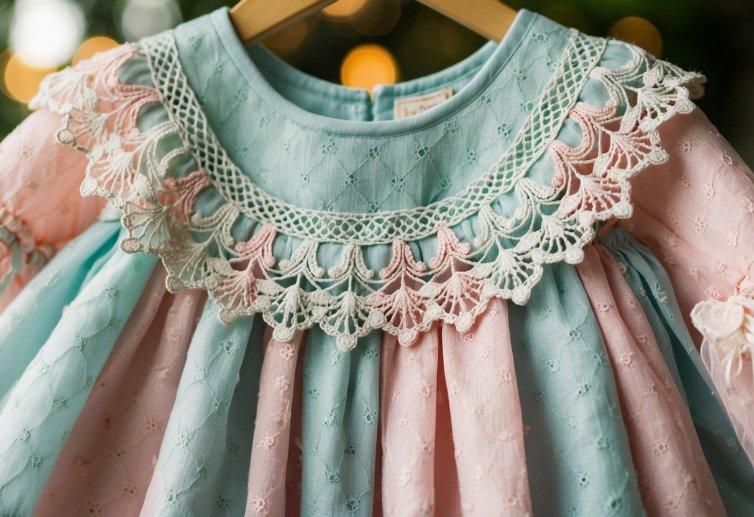From delicate embellishments to practical applications: Understanding when and how to incorporate this timeless fabric into your child’s wardrobe
Lace has adorned children’s clothing for centuries, adding elegance and charm to special occasion wear. From delicate needle lace designs to sturdy machine-made trims, modern lace comes in many forms that make kids’ clothes both beautiful and practical.
Today’s lace clothing for children combines traditional craftsmanship with modern manufacturing methods. Medieval fashion influences still shape how we use lace in children’s clothing, though the materials and techniques have evolved significantly over time.
The versatility of lace means it appears in everything from christening gowns to everyday dresses. Different types of lace, such as bobbin lace and tatted lace, create unique textures and patterns that enhance children’s garments while maintaining comfort and durability.
On This Page
Key Takeaways
- Lace combines traditional craftsmanship with modern manufacturing for today’s children’s clothing
- Various lace-making techniques create distinct patterns suited for different garment types
- Machine-made lace offers durability and style for everyday children’s wear
History of Lace in Children’s Fashion
Lace played a significant role in children’s fashion starting from the 15th century. The intricate fabric decorated special garments like christening gowns and ceremonial clothing.
Origin and Evolution of Lace
The craft of lacemaking began in Italy during the Renaissance period. The Florentine School developed early techniques for creating delicate patterns that adorned children’s formal wear.
Needle lace and bobbin lace were the two main techniques used to create garments for wealthy children. These methods required great skill and patience.
Rich families displayed their status by dressing their children in lace-trimmed clothing. The more elaborate the lace, the higher the family’s social standing.
Lace in European Clothing
Belgian schools taught children the art of lacemaking from an early age. This tradition helped maintain high-quality handmade lace production across Europe.
French and Flemish artisans created distinctive styles that became popular in children’s fashion. Chantilly lace became especially prized for special occasions.
Children’s clothing featured lightweight and open lace patterns with delicate holes and frills. These designs appeared on collars, cuffs, and dress hems.
Royal and noble families often passed down lace garments through generations as precious heirlooms.
Types and Techniques of Lace
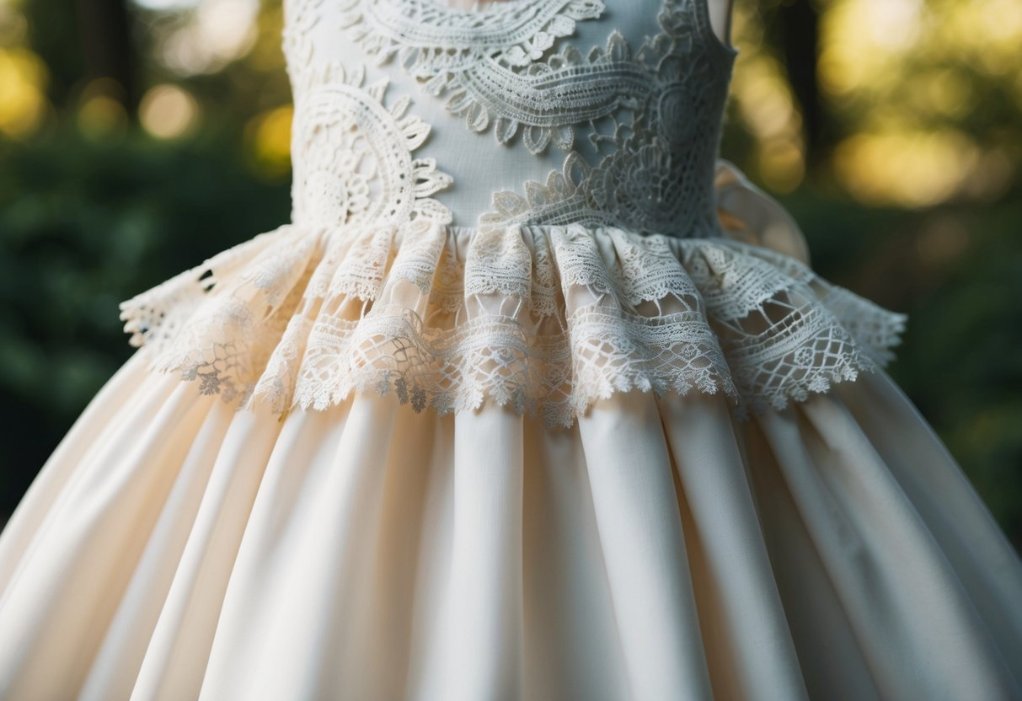
Lace fabric comes to life through many different methods, from handmade techniques that take great skill to modern machine production. Each type creates unique patterns with its own special look.
Needle Lace Versus Bobbin Lace
Needle lace uses a single thread and needle to create delicate patterns stitch by stitch. The lace maker works on top of a pattern that sits on cloth, building up intricate designs one tiny stitch at a time.
Bobbin lace needs more tools to make. Workers use several spools called bobbins, each holding thread. They twist and cross these threads around pins on a special cushion to form lovely patterns of flowers and leaves.
Both styles need lots of practice to master. Needle lace gives very fine, detailed results. Bobbin lace can create wider pieces with flowing designs.
Other Lace-Making Techniques
Tatting creates lace using a special shuttle or needle to make loops and knots. The result looks like tiny rings and chains linked together.
Crochet lace uses a hooked needle to make patterns. This technique is easier to learn than needle or bobbin lace.
Machine-made lace helps make pretty designs quickly and costs less than handmade types. Modern machines can copy most handmade styles, though experts can spot the difference.
Some people make lace through knitting and weaving. Macramé uses knots to create lacy patterns. Each method adds its own special touch to clothing and decorations.
Lace Material and Composition
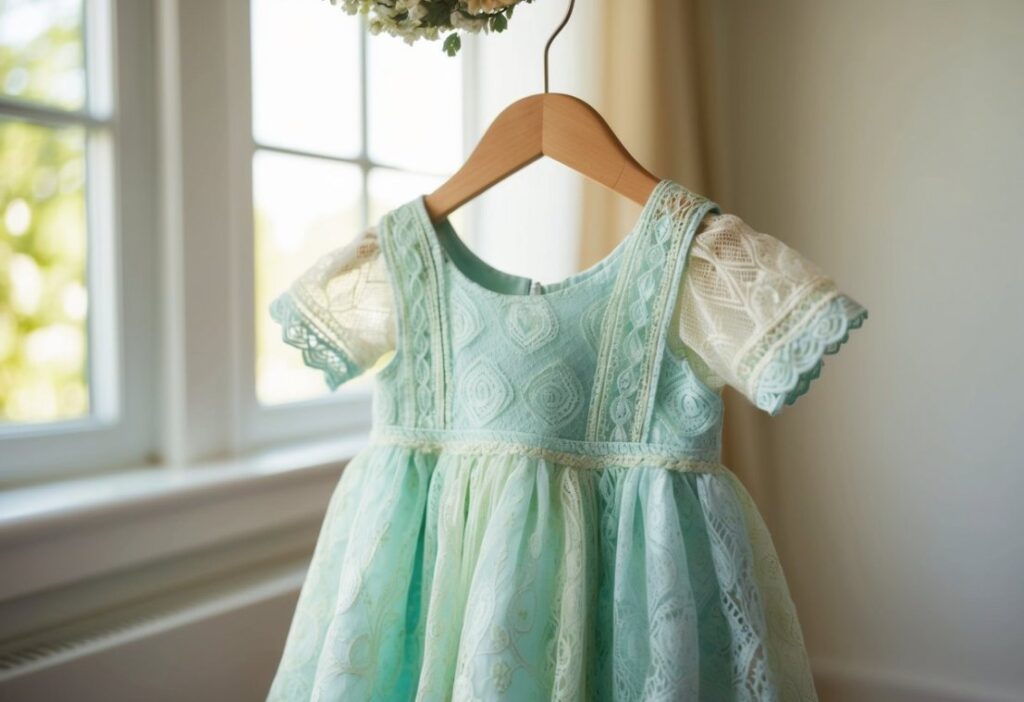
Lace fabrics combine different textile fibres to create intricate patterns with holes and designs. The type of fibre used affects how the lace looks, feels, and lasts.
Natural Fibres in Lace
Traditional lace was made from natural materials like cotton, silk, and linen. Cotton lace offers breathability and comfort, making it perfect for children’s clothing.
Silk lace creates a luxurious, soft texture that’s ideal for special occasion dresses. The material has a natural sheen that catches light beautifully.
Linen lace provides durability and becomes softer with each wash. It works well for collars and cuffs on children’s formal wear.
Synthetic and Blended Lace
Modern lace production often uses synthetic fibres or blends them with natural materials. Polyester lace resists wrinkles and maintains its shape well.
Nylon lace is strong and elastic, making it suitable for active children’s clothing. It dries quickly and keeps its colour after washing.
Blended laces combine the best qualities of different fibres. A cotton-polyester mix offers both comfort and durability, whilst remaining affordable for everyday wear.
Common Synthetic Blends:
- Polyester-cotton (65/35)
- Nylon-spandex
- Rayon-polyester
Design Elements in Kids’ Lace Clothing
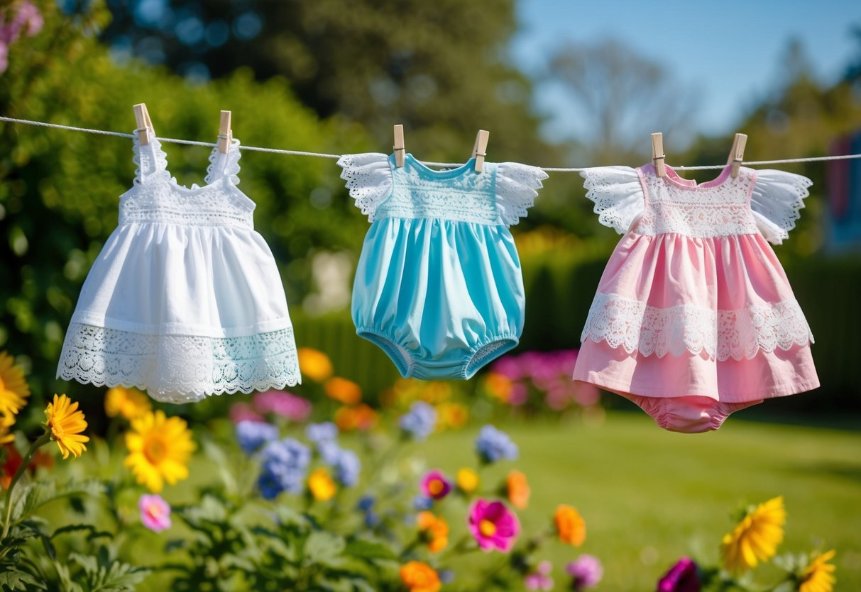
Lace adds elegant details and visual interest to children’s clothing through carefully crafted patterns and decorative elements. The thoughtful combination of motifs and finishing touches creates charming garments that delight both parents and little ones.
Patterns and Motifs in Lace
Needle lace features delicate floral designs with intricate roses, daisies and small leaf patterns. These nature-inspired elements connect seamlessly through loops and swirls.
Simple geometric shapes like diamonds and circles work well for everyday children’s wear. These basic patterns are durable enough for active kids while maintaining a neat appearance.
The most popular lace patterns include:
- Scalloped edges for hemlines and sleeves
- Butterfly motifs for special occasions
- Small heart designs for sweet details
- Repeated vine patterns that create borders
Adornments and Finishings
Traditional lace collars add a classic touch to party dresses and special occasion wear. Many feature pearl buttons or small ribbon accents at the neckline.
Cotton thread lace works brilliantly for decorative edges and trim. These finishing touches appear on:
- Sleeve cuffs
- Pocket borders
- Hemlines
- Necklines
Delicate lace overlays often incorporate tiny satin bows or covered buttons. These embellishments enhance the formal look whilst keeping the design child-appropriate.
Zips and fastenings are carefully concealed behind lace panels to maintain the garment’s elegant appearance.
Safety and Appropriateness of Lace for Children
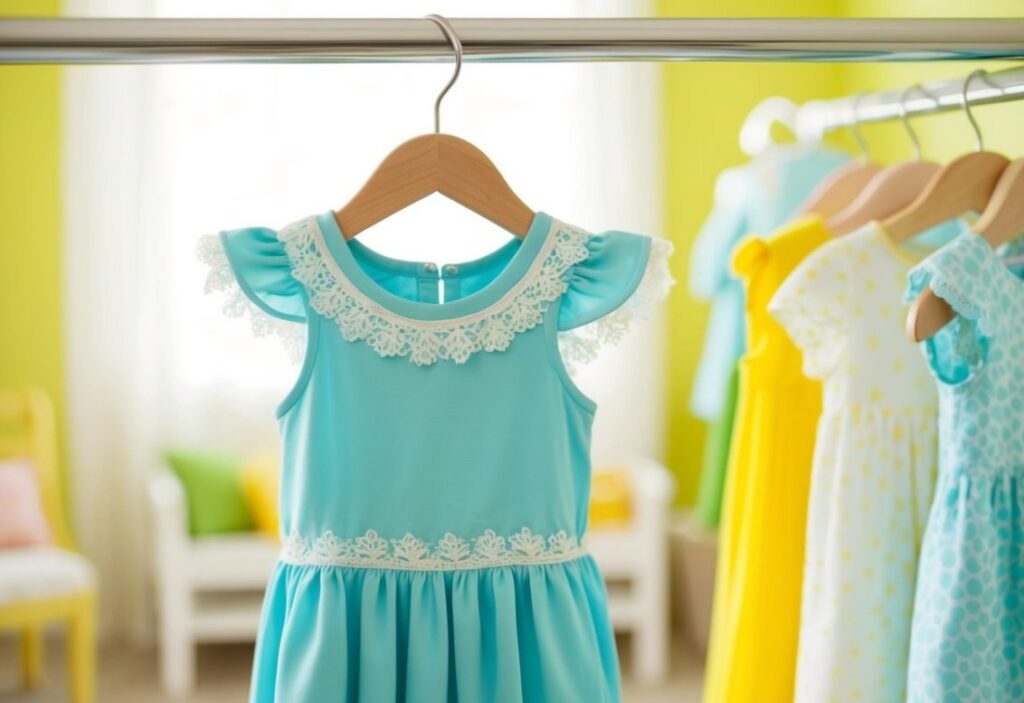
Lightweight lace fabrics require careful consideration for children’s clothing to ensure both safety and comfort. Parents need to evaluate the placement and construction of lace elements on garments.
Avoiding Hazards with Lace Features
Loose lace pieces and decorative pins can pose risks for young children. Always check for secure stitching and remove any temporary fasteners before wear.
Large open holes in lace patterns might catch on playground equipment or furniture. Choose lace with smaller, tighter patterns for active children.
Key Safety Checks:
- Ensure all lace edges are firmly attached
- Remove loose threads and hanging decorations
- Test for snagging before wear
- Avoid lace near the neck or wrists of sleepwear
Comfort and Practicality for Kids
Soft, lightweight lace works best for children’s clothing. Stiff or scratchy lace can irritate sensitive skin and cause discomfort.
Machine-washable lace is more practical for everyday wear. Many modern laces withstand regular washing without losing shape.
Best Uses for Lace in Children’s Clothing:
- Special occasion dresses
- Decorative collars
- Light summer tops
- Simple trim details
Choose lace placement carefully. Avoid areas that experience frequent movement or friction during play.
Fashion Trends in Kids’ Lace Clothing
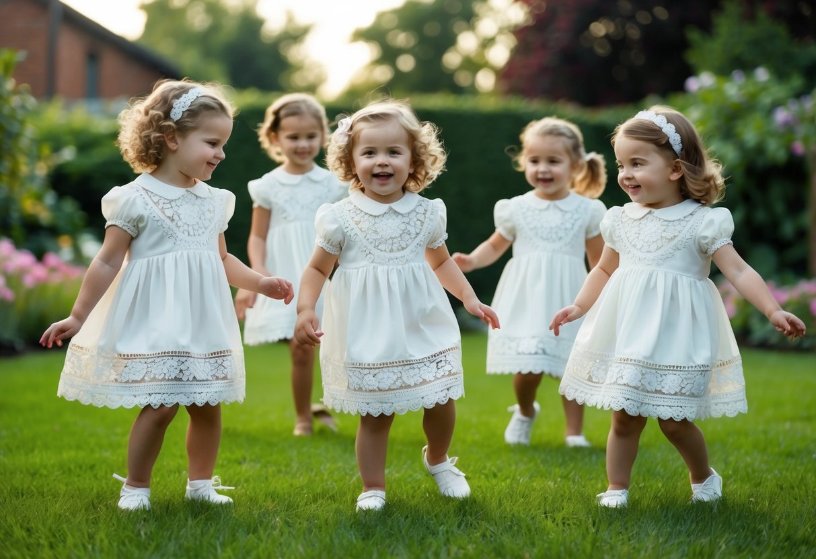
Lace never goes out of style in children’s fashion, with its delicate patterns and refined elegance enhancing both casual and formal wear. Modern designers blend traditional lace with contemporary styles to create versatile pieces that appeal to today’s young fashion enthusiasts.
Influence of Adult Fashion on Kids’ Clothing
The adult fashion world strongly shapes children’s lace clothing trends. Designer Collections now feature miniature versions of grown-up styles, with intricate lace details on collars, sleeves, and hems.
Contemporary lace dresses combine classic elements with modern silhouettes. Children’s fashion embraces both vintage-inspired pieces and bold, innovative designs.
Popular lace applications include:
- Layered lace overlays on party dresses
- Lace-trimmed t-shirts for everyday wear
- Delicate lace socks and accessories
- Mixed-material designs combining lace with denim
Periodic Revivals and Timeless Classics
Victorian-era inspired lace designs regularly return to children’s fashion, reminiscent of the elaborate styles worn during Queen Elizabeth I’s reign. These historical influences appear in special occasion wear and formal attire.
White lace remains a staple for children’s special events, particularly in:
- First communion dresses
- Junior bridesmaid gowns
- Birthday party outfits
- Holiday celebrations
Modern interpretations add fresh colours to traditional lace patterns. Pink, mint, and powder blue laces offer sweet alternatives to classic white, whilst maintaining the fabric’s timeless appeal.
Selecting the Right Lace Garment
Choosing lace clothing requires careful attention to quality, style and proper care techniques to ensure the garment stays beautiful and lasts longer.
Factors to Consider When Choosing Lace Clothing
Different types of lace come with unique patterns and textures that affect how the garment looks and feels. Light and airy lace works well for summer dresses, whilst denser patterns suit formal wear.
Look for garments with secure stitching along the lace edges. Check that the lace lies flat without puckering or pulling at the seams.
The clothing’s lining should be soft and smooth against the skin. Cotton-lined lace pieces offer the most comfort for children’s sensitive skin.
Key Features to Check:
- Even pattern throughout
- No loose threads or snags
- Proper fit with room to move
- Smooth inner lining
- Secure edge finishing
Care and Maintenance of Lace Apparel
Quality lace can last many years with proper care. Always check the garment’s care label before washing.
Hand wash delicate lace items in cool water with mild soap. Gently squeeze the water through – never wring or twist the fabric.
Lay wet lace garments flat to dry. Keep them away from direct sunlight to prevent yellowing.
- Store flat or hung properly
- Use garment bags for protection
- Spot clean small stains immediately
- Iron on low heat if needed
- Avoid harsh detergents
Lace in Home Decor and Accessories
Lace brings beauty and elegance to homes through decorative items and fashion pieces. Its delicate patterns create a soft, romantic atmosphere in any space.
Extent Beyond Attire
Lace trims add charm to window treatments and soft furnishings. Curtains with lace edges create a graceful look while letting gentle light filter through.
Tablecloths and bed linens become more sophisticated with lace borders. Many vintage-style homes feature lace doilies on wooden tables and dressers.
Throw pillows with lace detailing add texture and visual interest to sofas and chairs. The contrast between smooth fabrics and intricate lace patterns creates eye-catching designs.
Embellishing Objects with Lace
Lampshades gain a cosy feel when trimmed with delicate lace patterns. The light shining through creates lovely shadow patterns on walls.
Popular lace accessories include:
- Hair bands with lace overlays
- Lace-trimmed handbags
- Choker necklaces
- Picture frames
- Mirror borders
Museums like the Rijksmuseum display historical lace pieces that inspire modern home décor. These preserved items show how lace has beautified homes for centuries.
Frequently Asked Questions
Parents seek reliable answers about lace in children’s clothing to make informed decisions about garment selection, care, and historical significance. Lace remains a vital element in children’s fashion, combining both decorative appeal and practical considerations.
What are the distinctive features of lace used in children’s clothing through history?
Needle lace and bobbin lace were the primary types used in children’s garments. These techniques created intricate patterns that adorned collars, cuffs, and dress hems.
The patterns often featured floral motifs and geometric designs specifically scaled down to suit children’s proportions. Lighter weight laces were favoured for children’s clothing to ensure comfort and ease of movement.
How has the design of children’s lace garments evolved since the 1800s?
Children’s lace designs shifted from elaborate Victorian styles to simpler patterns in the early 1900s. Machine-made lace became more common, making decorative clothing accessible to more families.
The introduction of synthetic materials and mechanised production transformed lace from a luxury item to an everyday fabric choice for children’s special occasion wear.
What role did lace play in the fashion of 1920s children’s apparel?
The 1920s saw lace used extensively in christening gowns and special occasion dresses. Short, drop-waist dresses often featured lace trim and insertions.
White and ivory laces dominated children’s fashion during this period. Simple, geometric patterns replaced the more ornate Victorian designs.
In terms of fabric quality, which types of lace are most commonly found in children’s clothing?
Lightweight, open-patterned laces are most popular in children’s garments. Cotton and synthetic blend laces offer durability and easy care properties.
Tatted lace and machine-made varieties provide decorative elements whilst maintaining practical wear characteristics.
How have historical events influenced the use of lace in children’s fashion?
Wars and economic changes affected lace production and availability. The industrial revolution made machine-made lace more accessible to middle-class families.
Trade restrictions and material shortages during wartime led to creative adaptations in children’s lace designs.
What are the care considerations for lace garments in children’s wardrobes?
Gentle hand washing helps preserve delicate lace details. Storage in acid-free tissue paper prevents yellowing and fabric deterioration.
Regular inspection for loose threads and gentle repairs extend the life of lace garments. Air-drying flat helps maintain the shape and integrity of lace details.

